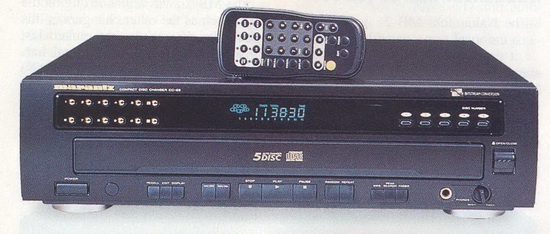Marantz CC-65 CD-changer
The Marantz CC-65SE is an impressive-looking five-disc carousel changer, presenting a glossy black front panel adorned with several spiffy gold-plated buttons. Its large drawer opens to reveal three disc wells, and pressing the load button (handily located on the drawer) rotates the carousel to expose the other two. Conveniently, the right-most well is always designated the "preferred position", so that when you load a disc there and press the drawer-mounted quick-play button that disc starts playing immediately. Unloading requires more effort, however, since the load button must be used to rotate the platter to retrieve the disc. The feature could be improved if the preferred-position disc were made to rotate out to the loading position when the drawer opened, which would make single-disc playback just as easy as with a single-disc player. You can load and unload discs from the carousel without interrupting one already playing. Better still, if you hit the load button while the drawer is open, the current disc is unloaded while the drawer, remains open - you don't have to close the drawer, stop playback, and open it again. Overall, the CC-65SE's ergonomics are very good.
The CC-65SE provides the usual features plus such extras as track and disc repeat, track intro-scan for one or all discs, random track and disc playback, repeat track and disc, and a headphone jack and level control. You can program sequences of as many as thirty tracks from any or all of the loaded discs. Several features are devoted to recording. You can fade the analog output in and out, and there is a peak-search function that fast-scans through a CD, then displays the track and time of the loudest passage on the disc and plays it repeatedly while you set the levels on your recorder - cool! A function Marantz calls Edit-Normal helps you select tracks to fit onto a tape side, or you can use the mode Marantz calls Edit-Optimal, in which the changer optimizes the track sequence to fill as much of a tape side as possible without overrun. You can select from a number of common cassette durations.
The changer's blue fluorescent display provides full alphanumeric information and status indicators, and a disc map shows how the changer is loaded. The supplied remote is unique in that it is two-sided: One side contains the bare-bones CD controls and a volume control, and the other adds buttons for features of other Marantz audio/video components. Its housing enables you to pick one side while concealing the other side. Very nifty.
The back of the CC-65SE has fixed-level analog outputs, a coaxial digital output, and remote-control in/out jacks. The player incorporates a newly developed Philips Bitstream D/A converter that uses single-bit pulse-density-modulation (PDM) conversion in combination with multibit conversion for the critical most significant bit (MSB). Downstream analog components include audiophile-grade op-amps and capacitors. Most of the digital audio circuitry inside the CC-65SE is built around the same integrated-circuit chips used in single-play Marantz CD players.
We encountered no problems with the CC-65SE on the test bench. Its D/A converter exhibited no linearity error down to -70 dB and only a tiny deviation at -90 dB. Other electrical measurements were also quite competitive. The disc change time of 7 seconds tied for first place, perhaps because the platter is designed to rotate bidirectionally for faster access.




